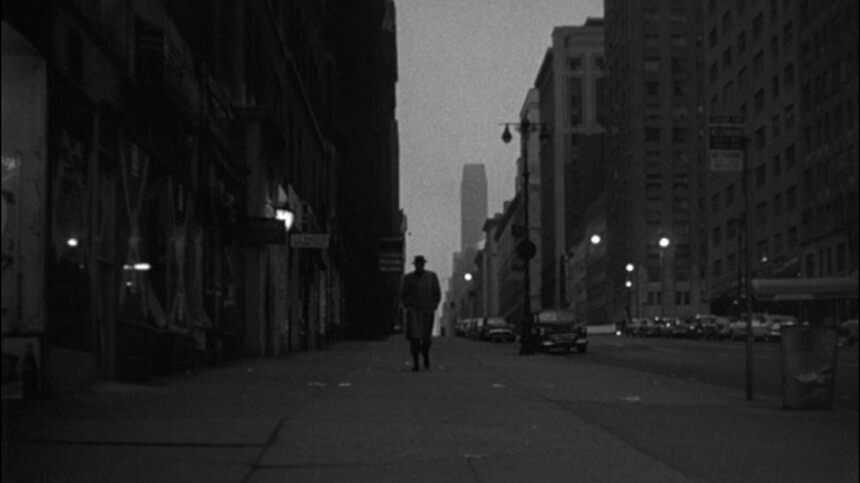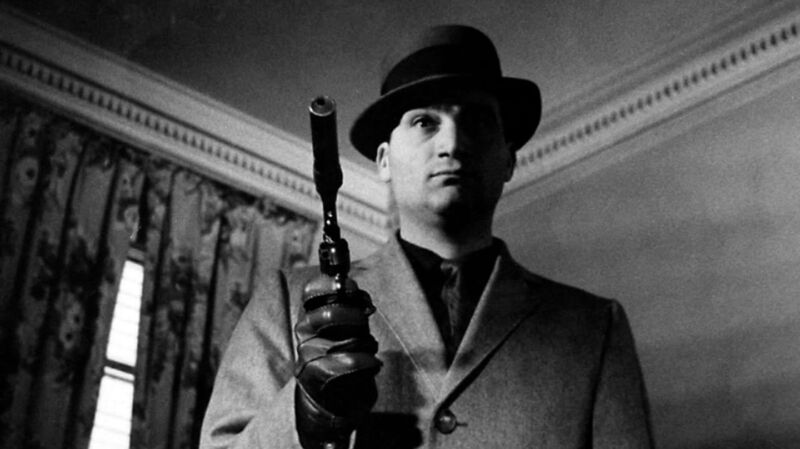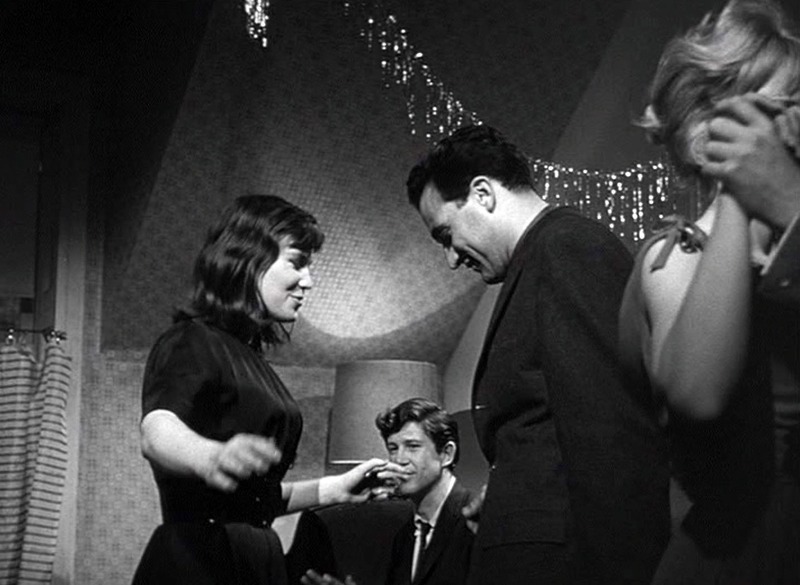BLAST OF SILENCE Blu-ray Review: A Cult Late Noir Gem Remastered

There's not an exact timeline for film noir, the genre moniker given to a certain kind of gritty crime film that flourished in the United States in the 20th century. It usually dates from the early 1940s to the late 1950s, a time when a dark disillusionment reigned over many people, even when the victories of WWII should have prevailed. It wasn't a victorious time for everyone, and many found themselves lost in the proverbial shuffle of the new American boom.
You could argue that it's one of the last noirs, or one of the first neo-noirs, but there is no arguing that Blast of Silence is a remarkable achievement. Made on a tiny budget, with a minimal cast and crew, mainly outdoor shooting on the streets of New York in days when shooting permits did not exist, it's an almost experimental and poetic film that focuses tightly on a few days in the life of a hitman. Intense, intimate, cruel, with the early winter wind constantly blowing, there is little room for warmth of hope in this tale of ennui and quiet desperation.
Frank Bono (played by writer and director Allen Baron) has come from Cleveland, having been hired to kill a middle-management-type man who runs prostitutes and drugs. Baron doesn't know why the man needs to die, and doesn't care. What he does know is that he hates big cities, and now he has to wait a few days to get the gun he needs for the killing. That means time on his hands in a place he doesn't want to be, waiting to complete his last job.
His last job. Well, we know what that means, but this film is about Frank's final journey. From the opening shot of a dark tunnel, a shaking camera meant to represent his strange birthing into the world, everything about this moment is harsh and cold and bright. This is how the world, it seems, has been to Frank since the day he was born. We know this via a voiceover narration, performed by Lionel Stander (at the time, a blacklisted actor) and co-written by Waldo Salt (under a pseudonym, as he too was blacklisted). While narration in noir films is common, it's not common to have it performed by another actor. And more to the point, this narration is in the third person. Is this the voice of God, talking to Frank? His future self (which we will find, is not the case)? The voice that Frank himself keeps inside because it is so hard and cynical? Or is it talking to us?
That voice is, in essence, every noir criminal protagonist distilled to his more pure form. Someone alone in the world, no matter how many people he is surrounded by; someone who can barely understand himself, but knows the job and how to get it done. It's only in the moments when that voice is quiet, does Frank seem to have second thoughts. He reconnects with an old crush, he tries to be one of the gang in their silly games. But that voice always pushed him too far and so pushes him away.
If there is a beauty in this New York, it is lost on Frank. Perhaps we, as audience, might find cheer in the decorative lights, the tree at Rockefeller Plaza, the red and green store fronts, but this means nothing to our morose anti-hero. Again, this city is boiled down to the hardness with which it responds to its traveller. Some of these shots are extraordinary: the black and white only enhances the coldness felt by Frank in the Christmas crowds. As he wanders down 34th street in those hours just after sunrise, when the city is still asleep, you could mistake it for an apocalypse film, Frank the last survivor. Even a brief moment in nature is bereft of life: an abandoned fishing village on the south shore of Long Island, close enough to see the highway, still connected to the city, but perhaps an even lonelier place to die.
Baron has the perfect face for this lonely hitman - in the brief evenings where he finds some prospect of happiness, first at the party of an old friend, later in what he thinks is a date, there is something of a young boy feeling the first giddyness of pleasure on his face. But when he returns to the streets, it's all hard angles on his face. He encounters the good, the bad, and the ugly, and he can't find his place with any of them.
The film fits in well with this new New York style of indie filmmaking beginning in the 1960s, which included work by Shirley Clarke and John Casavettes. Somewhat guerilla-style, pros working with amateurs, and a sense that the only way to tell the true stories of this city were to do it yourself. The kind of magic that come out of this scrappy indie filmmaker is fully on display in Blast of Silence. Both an homage to and perhaps something of a criticism of noir and its cynicism, a distillation of its essential components into a fractal poem.
Special Features
This new edition features a 4K digital restoration, in your choice of aspect ratios: the original widescreen, as it was shown in its theatrical release; and the 1.33:1 format, approved by Baron, that was used when the film found new life at film festivals in the 1990s. Oddly, I was partial to the smaller format - somehow it felt more noir-ish, the containment anbd tightness on screen feeling like an extension of the tightness slowly enveloping the main character. But both versions look amazing, with Criterion's impeccable quality.
A 1990 documentary Requiem for a Killer: The Making of "Blast of Silence", begins with Baron talking about his beginnings in art school and as a comic book illustrator, before moving into cinema. They start off where Baron grew up in Brooklyn, and he would talk about how he would play kick-the-can, and how he ended up taking the lead role in his film because 'I was the only [actor] I could afford'. The crew then follows Baron around New York to the various locations film. Given the structure of the story, this is the perfect way to have Baron remember stories from the production - how they had an encounter with police, since they were just randomly filming. How Baron loved the energy of Harlem, even as his character hated it. Probably the most interesting visit is to the old abandoned fishing village, now very close to JFK airport, still isolated and strange at this semi-urban edge of Long Island.
Alongside this documentary are two sets of photos - some are polaroids that Baron and others took on set, which brings up a wistful nostalgia and an eerieness, as if there are ghosts waiting to be released. The other set of photos were done by Criterion for the disc's 2008 release, showing Baron at the film's locations. This might seem repetitive, but this would not be the same film if it was not New York, and it's interesting to see how much has changed.
Terrence Rafferty's essay provides some interesting background information (apparently Peter Falk had at one point been in consideration for the lead role), about what filmmaking was like in this era, and placing Baron among those who wanted to show a different kind of New York. But the highlight of the extras is a comic, drawn by Sean Phillips: he takes moments from the film, and the narration, and creates a stunning work in just a few pages, evoking the visual mood and emotional tone. I almost wish there was a full length version.
The film is now available from the Criterion Collection.
Blast of Silence
Director(s)
- Allen Baron
Writer(s)
- Allen Baron
- Waldo Salt
Cast
- Allen Baron
- Molly McCarthy
- Larry Tucker
Requiem for a Killer: The Making of 'Blast of Silence'
Director(s)
- Robert Fischer
- Wilfried Reichart
Writer(s)
- Robert Fischer
- Wilfried Reichart
Cast
- Allen Baron
- Lionel Stander









